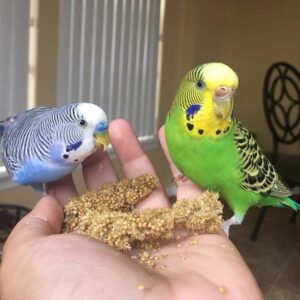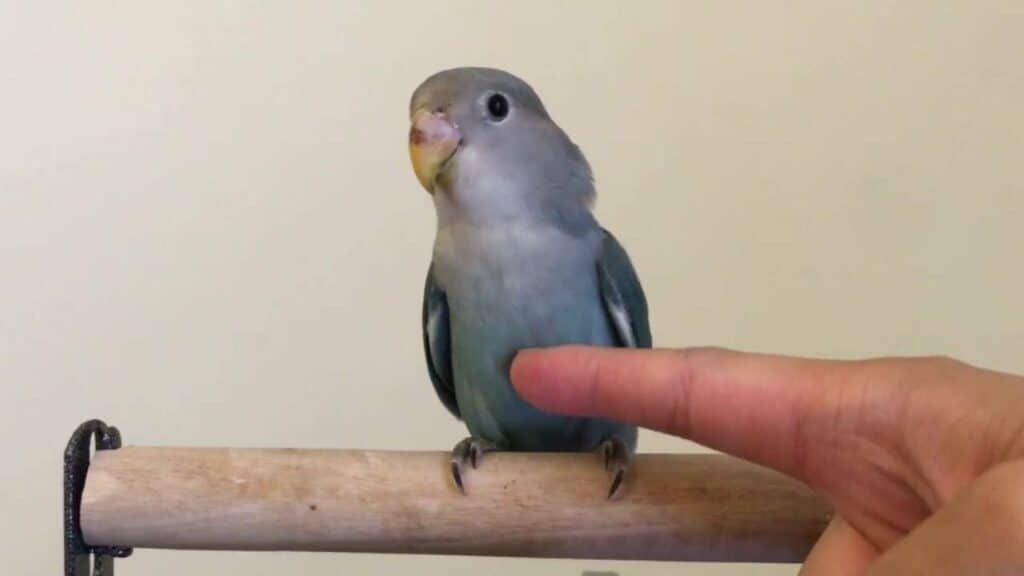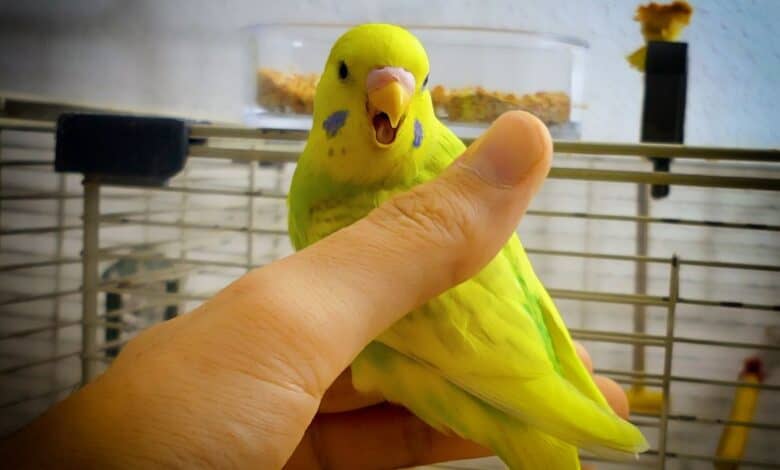Welcome to my guide on taming parakeets!
If you’ve ever wanted to build a rewarding and delightful bond with these charming birds, you’re in the right place.
In this article, I’ll walk you through some easy and effective methods to tame your parakeet and turn it into a friendly and interactive companion.
Let’s dive into the world of parakeet training and create a strong connection together.
If you want to tame a parakeet and you want to know the tips and tricks of managing and teaching a parakeet to understand you, you need to follow our guidelines in this discussion.
Prerequisites
Before you start to tame your parakeet with gestures and your voice, you should take care of some things that are necessary to do in case of an accident that your bird may get affected.
You must choose a young parakeet as they are quick learners and have the wings of that parakeet cut so that it doesn’t wander off or fly unnecessarily while training.
If you are working on a more seasoned parakeet, you need to realize that restraining isn’t incomprehensible yet will take longer.
Let the parakeet grow and get familiar with the environment first; then, you can start the taming process.
To start, you need to keep your parakeet comfortable in its cage.
Provide him with proper food and clean dishes, so he gets used to the environment and develops a sense of understanding with you.
This was just a basic step; now, you can start the actual taming process that we have discussed in the points below.
Taming a New Parakeet
You know that it’s not easy for any bird or animal to adjust to a new environment, and if you have a wild parakeet, then you have to be more than extra careful for all of his behavior and acts that he may perform in the cage or in your home.
Observe your bird carefully and see whether it gets well along in the cage or outside the cage, and you should also cut the wings of your parakeet so that it doesn’t fly off.

Understand your bird for a week first, and then see how the bird gets along with you and responds to you.
A bird who has been in a pet shop and had the human interaction or general hustle would easily adjust with you, and then it would be easy for you to tame that parakeet, but if the bird is shy and didn’t have any past experience, then the process might take some time.
Taming a Female Parakeet
You need to be aware of the situation that parakeets do respond differently to the owner, depending on their sex type.
If you have a female parakeet that you want to train, then it might be hard for you because they are usually more aggressive and bossy in nature.
If you start training a female parakeet at a very young age, then it can adjust easily to your instructions.
To begin with, taming your male or female parakeet, you should start gently with little gestures or some voice communication to see if the parakeet responds well or not.
Try standing close to the cage every day and talking in your voice gently with your bird.
Try using your hand gesture by moving it up and down slowly while talking to your parakeet.
With a time of about 2 to 5 days, your parakeet may start responding to your gesture and your soft voice and understand you.
It will begin his own chatter.
How to Finger Train Your Parakeets?
This is the first and basic training of your parakeet as you would want your parakeet to sit on your finger as his perch.
You can start by feeding your parakeet by bribing it with a seed or a millet so that he follows that millet towards your finger.

- First of all, place the millet or treat between the center of your finger and thumb, and then slowly offer the food to your parakeet. Keep the millet in the top position so that the parakeet can see it and let him get on top of your finger to get the millet or treat.
- Keep patience and wait for it to get close because the parakeet won’t come close on the first attempt, so you have to repeat the process many times and wait a lot in order to get the training done. Remember that the bird won’t come close to your finger on the first attempt, so you need to attempt this process again and again and wait for a few minutes until it gets comfortable. This can take days or sometimes weeks, so just be patient.
- In the long run, your parakeet will not have the option to oppose the bait of the millet and will edge closer to it. Ensure that it can’t arrive at the food without going onto your finger. Pursuing a parakeet around the cage with your hand trying to get him on your finger may be counterproductive and is bound to make your bird dread your hand.
Getting Out of Cage Training
The next step you need to tame your parakeet for is getting out of the cage at your instructions.
In the beginning, the bird may jump from the hand and get back to the cage, but you need to stay patient and try getting the parakeet on your finger and then remove the hand from the cage while using voice instructions as well.
The parakeet may jump again and again from your hand, but eventually, he will get used to it, and a time will come when he won’t jump.
So you can use your voice instructions while removing your hand slowly from the cage, and your parakeet will learn to get out of the cage with your instructions either with or without your hand.
Perch Training
The perch training is easy training for your parakeet, and you can start just like finger training.
The difference will be that sometimes parakeets may bite or nip on your finger when you are holding them or moving them on the finger.
They would react out of fear, but in the case of a perch, you are harmless, and you can use little perch to train your parakeet to sit on it.
- Now perch training is a bit tricky, but you will get to it. You have to place your parakeet on the perch by yourself for the first time with your hand.
- Then you have to pick him up from the perch by covering him under a cloth or towel or something like that so that you won’t hurt your parakeet in picking him up and placing him down again and again.
- Then again, you may repeat the process of placing him back on the porch with your hand. You can perform this step 5 times so that your parakeet gets the idea of what you are doing.
- Try to keep talking to your bird in a calm voice while you are repeating this process so that the bird remains in a comfortable and calm position.
- After when you do this process of placing him on the porch for the last time, tap him gently and praise him with love and say kind words to him as if you are communicating with him. The bird may not understand your language, but he may start to think that you like what he is doing.
- After when your parakeet gets comfortable and happy doing all this, you will have the idea, and it would be easier for both of you to make him sit on the porch easily. He will start to chirp a lot when he is happy.
Training Parakeets to Step Up and Step Down

The next taming part is the step up and steps down, and you can train your parakeet to do this by following this process.
- When your parakeet is sitting idle on its perch, place your finger in front of him right next to his lower abdomen near his feet and talk to him gently and say, “Step up“.
- He won’t understand, but he will think that you want him to do something, so with time, he will raise his foot and step onto your finger. Once he does that, you can continue this process.
- Place the next finger in front of him but a bit higher and again tell him to step up and then continue doing that until he completely learns this trick.
- Once your pet learns to do all this step-up game, give him a few taps and praise him with love by waving a hand over his head and back and telling him how proud you are in a gentle soft tone.
- After he has done a good job, give him some rest and give him a good treat or millet as a reward for his work.
- Then you can start with step down the game in the same way. Hold him high with your finger or using a perch, and then place your next finger a bit low next to your parakeet while telling him to step down gently. You can use a treat or millet as bait to make him move his steps toward the treat.
- Then continue this process until he learns to step down from perch or your fingers.
Getting Parakeet Back to the Cage
After you are done teaching him the step up and step down, you need to tame your parakeet for getting back into the cage.
Once the parakeet gets comfortable with you, it would be an easy task as the parakeet would become already familiar with your voice and activity.
So he will cooperate more than ever.
You need to present your parakeet back to its cage with your finger.
In the beginning, you may have to use bait or lure him into the cage using millet or treats so that he walks into the cage.
Try to use the fruit or bait that your parakeet likes the most to lure him back to the cage.
Repeat this process eventually, and your parakeet will learn to get back in the cage easily with time.
Taming a Parakeet to Avoid Biting
Parakeets can bite the owner sometimes as these are wild birds, and you never know what can make them angry at the time.
So you should also know how to tame your parakeet to not to bite a finger when you are keeping them.

- If your parakeet is finger trained, then he won’t get offended when you enter the hand in the cage.
- If you move your parakeet to a new cage or room, it may make him anxious and react, which may result in him biting your hand in case of contact.
- If there is a lot of noise in the room or around you, then it is also possible that your bird may get frustrated, and as a result, it is starting to bite you when you get closer. Try to remove anything that is irritating the bird. Usually, parakeets bite the hand when you feel insecure or alert of danger around them.
- If your bird is an aggressive parakeet and he loves biting everyone, don’t try to give him treats or millet to avoid his bites. He will start to think that you are rewarding him for his behavior, and he will continue to do this. Try not to feed him when he makes a habit of biting a lot.
- There is a possibility that your bird is probably lonely or is not on a good diet which is making him behave like this. So should be providing him proper diet on time to take care of his appetite.
- If your bird is not getting good sleep due to noise or due to the environment around it, then it is sleep-deprived, and most probably, he would have a bad mood all day to adopt the biting habit. Try covering the cage of your parakeet to let him sleep properly in the mid of the night.
- You should know that you don’t have to grab your bird and make him feel like you are trying to restrain it or holding it against his will. If you hold your bird against his will with a grab knot, he may probably bite you just in case of self-defense.
- If your parakeet is lonely or bored, then in order to get the attention of the owner, he may tend to bite his hands on a regular basis. Try to keep him entertained and indulged in activities by providing him with toys so that he can play all day with them.
You would need to be patient for all this as they won’t learn things from you within a day.
Don’t make your parakeet feel like you are a predator and you are going to harm him.
These birds are always alert and looking for any kind of danger around them.
Conclusion
In conclusion, taming a parakeet doesn’t have to be a daunting task.
By employing the easy methods outlined in this article, you can transform a skittish and distant bird into a trusting and affectionate friend.
Remember, patience, consistency, and a gentle approach are key throughout the taming process.
Building a strong bond with your parakeet not only enhances your companionship but also enriches both of your lives.
So, embark on this journey with confidence, and enjoy the fulfilling experience of having a well-tamed parakeet by your side.
Happy taming!
FAQ
How long does it take to tame a parakeet?
The time it takes to tame a parakeet can vary widely depending on the bird’s personality, age, and consistency in training. It can take anywhere from a few weeks to a few months to establish a strong bond.
Can I tame an older parakeet?
Yes, older parakeets can be tamed, although it might take a bit more patience and time. The key is to approach the taming process gently and gradually, allowing the bird to become comfortable with your presence.
What are the essential tools for taming a parakeet?
The most important tools are patience, time, and positive reinforcement treats. Additionally, having a quiet and safe space for training sessions and a comfortable perch can greatly aid the process.
How do I know if my parakeet is starting to trust me?
Signs of a trusting parakeet include approaching you voluntarily, hopping onto your hand or finger, and accepting treats from your hand. The bird will also show relaxed body language and might start preening in your presence.
My parakeet is afraid of my hand. What should I do?
If your parakeet is fearful, take things slowly. Begin by placing your hand near the cage without making sudden movements. Gradually move your hand closer over time, ensuring that the parakeet remains comfortable. Offer treats from your hand to encourage positive associations.
Last Updated on August 8, 2023 by Lily Aldrin
